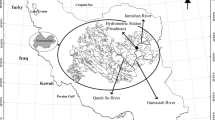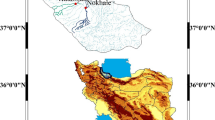Abstract
Regarding the complexity and limitations of current knowledge, monthly inflow prediction is often not sufficiently accurate and cannot fulfil the needs in water resource planning. Such time series consist of periodic and random components. Thus, by using data pre-processing methods, it is possible to reduce the problematic effects of these components in the modeling process. Monthly inflow methods encompass statistical and soft computing methods. Each of these methods has advantages and disadvantages. In this study, a hybrid model comprising both methods’ advantages is presented. This four-step model includes seasonal autoregressive integrated moving average (SARIMA) and adaptive neuro fuzzy inference systems (ANFIS), which is a new hybrid model (SARIMA-ANFIS). The first step entails data pre-processing to prepare the data for linear component modeling. In the second step, the linear and nonlinear terms are estimated by the SARIMA model. In the third step, some goodness of fit tests are applied to investigate the validity of the linear and nonlinear components of decomposed inflows and SARIMA model parameters. Upon the confident correct selection of components, in the fourth step the nonlinear components are modeled by ANFIS. In this method, ANN modeling is used instead of ANFIS (SARIMA-ANN model). The result comparison indicates that the ANFIS is more accurate than artificial neural networks (ANN) and SARIMA-ANN models, and SARIMA-ANFIS is the superior model among all.







Similar content being viewed by others
References
Asadi S, Shahrabi J, Abbaszadeh P, Tabanmehr S (2013) A new hybrid artificial neural networks for rainfall–runoff process modeling. Neurocomputing 121:470–480
Atiaa AM (2015) Modeling of stage-discharge relationship for Gharraf River, southern Iraq by using data driven techniques: a case study. Water Utility J 9:31–46
Barman S, Bhattacharjya RK (2015) Comparison of linear regression, non-linear regression and artificial neural network model for downscaling of rainfall at Subansiri river basin, Assam, India. Eur Water 51:51–62
Cadenas E, Rivera W (2010) Wind speed forecasting in three different regions of Mexico using a hybrid ARIMA-ANN model. Renew Energ 35:2732–2738
Chebaane M, Salas JD, Boes DC (1995) Product periodic autoregressive processes for modeling intermittent monthly streamflows. Water Resour Res 31:1513–1518
Coulibaly P, Anctil F, Bobee B (2000) Daily reservoir inflow forecasting using artificial neural networks with stopped training approach. J Hydrol 230:244–257
Ebtehaj I, Bonakdari H (2013) Evaluation of sediment transport in sewer using artificial neural network. Eng Appl Comput Fluid Mech 7(3):382–392
Ebtehaj I, Bonakdari H (2014) Performance evaluation of adaptive neural fuzzy inference system for sediment transport in sewer. Water Resour Manag 28:4765–4779
Faruk DÖ (2010) A hybrid neural network and ARIMA model for water quality time series prediction. Eng Appl Artif Intell 23:586–594
Firat M (2008) Comparison of artificial intelligence techniques for river flow forecasting. Hydrol Earth Syst Sci 12:123–139
Haykin SS (2009) Neural networks and learning machines. Pearson education upper Saddle River, New Jersey, USA
He Z, Wen X, Liu H, Du J (2014) A comparative study of artificial neural network adaptive neuro fuzzy inference system and support vector machine for forecasting river flow in the semiarid mountain region. J Hydrol 509:379–386
Jain A, Kumar AM (2007) Hybrid neural network models for hydrologic time series forecasting. Appl Soft Comput 7:585–592
Jang JSR (1993) ANFIS: adaptive-network-based fuzzy inference system. IEEE Trans Syst Manage Cybernet 23(3):665–685
Jang JSR, Sun CT, Mizutani E (1997) Neuro-fuzzy and soft computing: a computational approach to learning and machine intelligence. [book review]. IEEE Trans Autom Control 42:1482–1484
Jeong K, Koo C, Hong T (2014) An estimation model for determining the annual energy cost budget in educational facilities using SARIMA (seasonal autoregressive integrated moving average) and ANN (artificial neural network). Energy 71:71–79
Kavousi Fard A, Akbari Zadeh MR (2014) A hybrid method based on wavelet ANN and ARIMA model for short-term load forecasting. J Exp Theor Artif In 26:167–182
Khashei M, Bijari M (2011) A novel hybridization of artificial neural networks and ARIMA models for time series forecasting. Appl Soft Comput 11:2664–2675
Kisi Ö, Cigizoglu HK (2007) Comparison of different ANN techniques in river flow prediction. Civ Eng Environ Syst 24:211–231
Kumar S, Tiwari MK, Chatterjee C, Mishra A (2015) Reservoir inflow forecasting using ensemble models based on neural networks wavelet analysis and bootstrap method. Water Resour Manag 29:4863–4883
Liu H, Tian HQ, Li YF (2012) Comparison of two new ARIMA-ANN and ARIMA-Kalman hybrid methods for wind speed prediction. Appl Energ 98:415–424
Moeeni H, Bonakdari H (2016) Forecasting monthly inflow with extreme seasonal variation using the hybrid SARIMA-ANN model. Stoch Env Res Risk A. doi:10.1007/s00477-016-1273-z
Moeeni H, Bonakdari H, Ebtehaj I (2017b) Monthly reservoir inflow forecasting using a new hybrid SARIMA genetic programming approach. J Earth Syst Sci 126:1–13
Moeeni H, Bonakdari H, Fatemi SE, Zaji AH (2017a) Assessment of stochastic models and a hybrid artificial neural network-genetic algorithm method in forecasting monthly reservoir inflow. INAE Lett. doi:10.1007/s41403-017-0017-9
Mohan S, Vedula S (1995) Multiplicative seasonal ARIMA model for longterm forecasting of inflows. Water Resour Manag 9:115–126
Nawaz N, Harun S, Talei A (2015) Application of adaptive network-based fuzzy inference system (ANFIS) for river stage prediction in a tropical catchment. Appl Mech Mater: Trans Tech Publ 735:195–199
Pandhiani SM, Shabri AB (2015) Time series forecasting by using hybrid models for monthly streamflow data. Appl Math Sci 9:2809–2829
Pektas AO, Cigizoglu HK (2013) ANN hybrid model versus ARIMA and ARIMAX models of runoff coefficient. J Hydrol 500:21–36
Ruiz-Aguilar J, Turias I, Jiménez-Come M (2014) Hybrid approaches based on SARIMA and artificial neural networks for inspection time series forecasting. Transport Res E-Log 67:1–13
Ruiz-Aguilar J, Turias I, Jiménez-Come M (2015) A novel three-step procedure to forecast the inspection volume. Transport Res C-Emer 56:393–414
Salas JD, Chung CH, Cancelliere A (2005) Correlations and crossing rates of periodic-stochastic hydrologic processes. J Hydrol Eng 10:278–287
Valipour M (2015) Long-term runoff study using SARIMA and ARIMA models in the United States. Meteorol Appl 22:592–598
Valipour M, Banihabib ME, Behbahani SMR (2013) Comparison of the ARMA, ARIMA and the autoregressive artificial neural network models in forecasting the monthly inflow of Dez dam reservoir. J Hydrol 476:433–441
Voronin S, Partanen J (2014) Forecasting electricity price and demand using a hybrid approach based on wavelet transform ARIMA and neural networks. Int J Energ Res 38:626–637
Wang KH, Altunkaynak A (2011) Comparative case study of rainfall-runoff modeling between SWMM and fuzzy logic approach. J Hydrol Eng 17:283–291
Wang WC, Chau KW, Xu DM, Chen XY (2015b) Improving forecasting accuracy of annual runoff time series using ARIMA based on EEMD decomposition. Water Resour Manag 29:2655–2675
Wang J, Hu J, Ma K, Zhang Y (2015a) A self-adaptive hybrid approach for wind speed forecasting. Renew Energ 78:374–385
Yurekli K, Kurunc A, Ozturk F (2005) Application of linear stochastic models to monthly flow data of Kelkit stream. Ecol Model 183:67–75
Zhang GP (2003) Time series forecasting using a hybrid ARIMA and neural network model. Neurocomputing 50:159–175
Author information
Authors and Affiliations
Corresponding author
Rights and permissions
About this article
Cite this article
Moeeni, H., Bonakdari, H. & Ebtehaj, I. Integrated SARIMA with Neuro-Fuzzy Systems and Neural Networks for Monthly Inflow Prediction. Water Resour Manage 31, 2141–2156 (2017). https://doi.org/10.1007/s11269-017-1632-7
Received:
Accepted:
Published:
Issue Date:
DOI: https://doi.org/10.1007/s11269-017-1632-7




